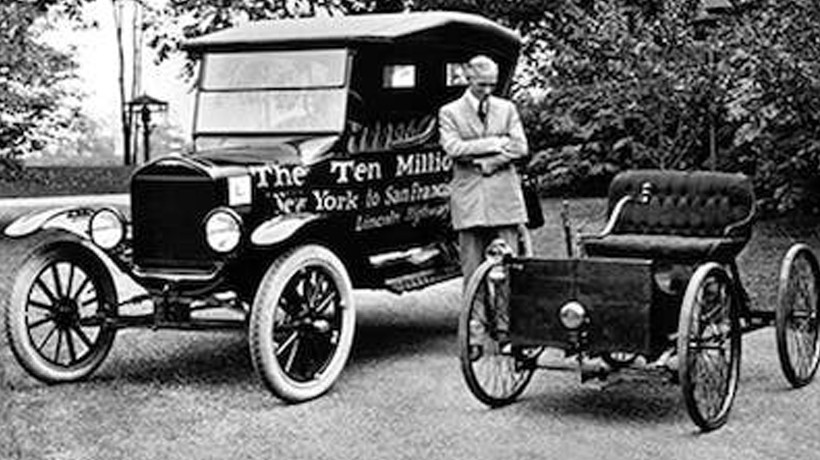
Introduction
The Ford Company story is a testament to innovation, resilience, and an unwavering commitment to excellence. In this comprehensive article, we will delve into the remarkable history of the Ford Company, exploring its evolution, key milestones, innovations, and lasting impact on the automotive industry. Join us on a journey through time as we uncover the rich tapestry of the Ford Company’s legacy.
The Early Years

The Ford Company story begins in 1903 when Henry Ford and a group of investors founded the Ford Motor Company. This pivotal moment marked the start of a revolution in the automotive industry.
In 1863, Henry Ford was born in Dearborn, Michigan. He always had a fascination with machines and was a tinkerer from a young age. His first self-propelled machine, a four-wheeled quadricycle, was constructed in 1896. When Henry Ford established the Ford Motor Company, which would grow to be among the biggest and most successful businesses in the world, he was 39 years old. It is among the biggest family-controlled businesses worldwide and has been under continuous family ownership for more than a century.
Ford Motor Company, also referred to as Ford, is a multinational automaker based in Dearborn, Michigan, in the United States. Henry Ford created the company, and on June 16, 1903, it was incorporated. Under the Ford brand, the corporation sells automobiles and commercial vehicles, and under the Lincoln brand, it sells luxury vehicles. In 1903, the Ford Motor Company was established in a remodeled factory with $28,000 in cash from twelve investors.
The Founding Vision
Henry Ford’s vision was clear: to make automobiles affordable and accessible to the masses. This vision led to the development of the Model T, a groundbreaking innovation that would change the world.
The Model T Revolution
The introduction of the Model T in 1908 was a game-changer. Its affordability and reliability made it a success, and it quickly became the most popular car in America. The Ford Model T was a groundbreaking vehicle. It was inexpensive, dependable, and easy to use. Ford was able to drastically cut production costs by employing an assembly line to mass-produce the Model T. After only a few years, the Model T shot to popularity in America, with over 15 million sold between 1908 and 1927.
Assembly Line Revolution
In 1913, Henry Ford introduced the assembly line, revolutionizing manufacturing. This innovation dramatically reduced production time and costs, making the Model T even more accessible. By 1914, Ford had popularized a system of highly engineered manufacturing sequences marked by moving assembly lines for both large-scale automobile manufacturing and large-scale labor force management. This system was dubbed “Fordism.” In March 2008, Ford sold its UK businesses, Jaguar and Land Rover, which it had bought in 1989 and 2000, respectively, to the Indian carmaker Tata Motors. From 1999 until 2010, Volvo was owned by Ford.
Innovations that Shaped the Industry

The Ford Company has been a pioneer in the automotive world, introducing innovations that set new standards for the industry.
Introduction of the V8 Engine
In 1932, Ford introduced the V8 engine, bringing power and performance to their vehicles. This innovation set the bar for future engine designs.
The Birth of the F-Series
The Ford F-Series, launched in 1948, has become an icon in the truck industry. Its durability, power, and versatility have made it a favorite among consumers.
Safety First: The Seat Belt
Ford prioritized safety by introducing the modern seat belt in 1955. This life-saving invention has become a standard feature in all vehicles.
Expanding Global Footprint
Ford had a significant influence on the world. The Model T is recognized for changing American society and for making the automobile more widely available. Ford’s assembly line production innovations had a significant effect on the manufacturing sector as well. The Ford Company’s reach extended beyond the United States, making it a global powerhouse.
International Expansion
Ford expanded internationally in 1904 by opening its first branch in Canada. This marked the beginning of the company’s global presence.
Manufacturing on a Global Scale
Ford’s commitment to innovation extended to manufacturing processes. It established plants worldwide, demonstrating its commitment to local markets.
The Legacy Continues
The Ford Company’s commitment to innovation, quality, and social responsibility continues to shape its legacy. The history of American innovation and brilliance is embodied in The Ford Motor Company. The business is still a leader in the automotive sector and has had a significant influence on the world we live in today.
Sustainability Initiatives
Ford has invested in sustainable technologies and practices. Their electric and hybrid vehicles showcase a commitment to a greener future.
Charitable Initiatives
Since its founding in 1936, the Ford Foundation has focused on solving societal issues. It continues to be a powerful influence in charity.
Some More Things To Know About Ford :
Largest Manufacturer
Based on 2022 vehicle production, Ford ranks sixth globally (after Toyota, Volkswagen Group, Hyundai Motor Group, Stellantis, and General Motors) and as the second-largest carmaker in the United States. Ford was the fifth-biggest carmaker in Europe at the end of 2010.
Ford’s Role in World War 2
Ford was chosen by the US Department of War to construct the Consolidated B-24 Liberator bomber in large quantities at its Willow Run assembly factory during World War II. Ford’s companies in Germany and France, Ford Werke and Ford SAF, respectively, manufactured military vehicles and other equipment for the war effort of Nazi Germany. Ford used forced labor at the time for part of its operations in Germany.
Ford Today
Today, Ford is a well-known global automaker today that offers a number of well-known brands, such as Mustang, Lincoln, and Ford. The business is making significant investments in electric cars and autonomous driving technologies because it is dedicated to sustainability and innovation.
Ford Company Story FAQs
Q: When was the Ford Motor Company founded?
A: The Ford Motor Company was founded in 1903 by Henry Ford and a group of investors.
Q: What was the significance of the Model T in the Ford Company’s history?
A: The Model T, introduced in 1908, was a revolutionary car that made automobiles affordable and accessible to the masses, changing the automotive industry.
Q: What is the Ford F-Series known for?
A: The Ford F-Series, launched in 1948, is renowned for its durability, power, and versatility in the truck industry.
Q: What safety innovation is Ford known for introducing in 1955?
A: In 1955, Ford introduced the modern seat belt, prioritizing safety in their vehicles.
Q: How has Ford expanded its global presence?
A: Ford expanded internationally in 1904, establishing branches in countries worldwide, demonstrating its global reach.
Q: What is the Ford Foundation, and what does it focus on?
A: The Ford Foundation, established in 1936, is dedicated to addressing societal challenges and remains an influential force in philanthropy.
Conclusion
The Ford Company story is a remarkable journey of innovation, excellence, and a commitment to making a difference. From its humble beginnings to becoming a global automotive giant, Ford’s legacy is one of inspiration and achievement. As they continue to innovate and embrace sustainability, the Ford Company’s future promises to be as bright as its storied past.
